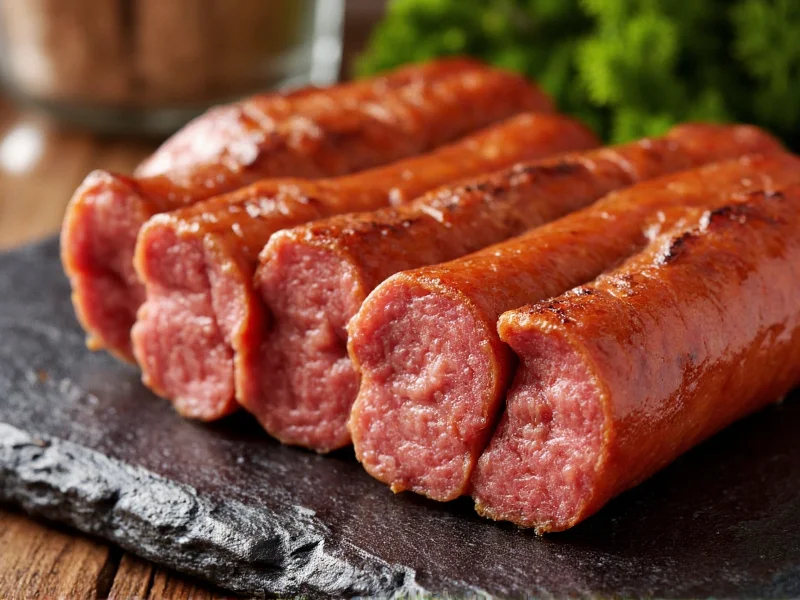Understanding what sets beef smoked sausage apart begins with its production process. This specialty meat product starts with coarsely ground beef, typically using cuts like chuck or round, combined with a precise blend of seasonings including garlic, black pepper, and paprika. The mixture is then stuffed into natural or synthetic casings before entering the smoking chamber.
The Traditional Smoking Process
Authentic beef smoked sausage undergoes a two-phase smoking process that significantly impacts its final characteristics. During the initial "cold smoking" phase (typically 80-100°F), the sausage absorbs smoke flavor over 6-12 hours without cooking the meat. This is followed by the "hot smoking" phase (150-180°F), where the sausage cooks thoroughly while developing its signature reddish-brown exterior.
The type of wood used in smoking creates notable flavor differences. Hickory delivers a strong, bacon-like flavor preferred in Southern styles, while mesquite provides a more intense, slightly bitter note popular in Texas varieties. Applewood and cherry wood produce milder, sweeter profiles common in Midwestern recipes.
Beef Smoked Sausage Varieties Compared
| Variety | Key Characteristics | Regional Origin | Distinctive Ingredients |
|---|---|---|---|
| Texas Style | Coarse grind, spicy heat | Texas | Cayenne, jalapeño, coarse black pepper |
| Midwestern Brat-Style | Finer grind, milder flavor | Midwest US | Nutmeg, coriander, subtle garlic |
| Southern Style | Medium grind, smoky-sweet | Southern US | Brown sugar, liquid smoke, mustard seed |
| Polish Kielbasa Style | Garlicky, U-shaped curve | Polish-American | Heavy garlic, marjoram, smoked over oak |
Nutritional Profile and Health Considerations
When evaluating the nutritional value of smoked beef sausage, a standard 3-ounce serving typically contains 250-300 calories, 22-25 grams of protein, and 18-22 grams of fat. Compared to pork sausage, beef varieties generally have slightly higher iron content but similar sodium levels (around 800-1000mg per serving).
For those monitoring sodium intake, look for "low-sodium" varieties which reduce salt content by 25-40%. Many premium brands now offer nitrate-free options using celery juice as a natural preservative, though these require stricter refrigeration. The smoking process itself creates compounds called polycyclic aromatic hydrocarbons (PAHs), but levels in commercially produced sausages remain within FDA safety guidelines.
Selecting Quality Products
When choosing the best beef smoked sausage, examine the ingredient list carefully. High-quality products list "beef" as the first ingredient without fillers like soy protein or breadcrumbs. Avoid products listing "smoke flavor" or "liquid smoke" as primary smoke sources—these indicate artificial processing rather than genuine smoking.
The casing provides another quality indicator. Natural sheep or hog casings create that characteristic "snap" when bitten, while collagen casings offer more uniform appearance but less texture variation. Premium varieties often feature hand-tied ends rather than machine-crimped closures.
Proper Storage and Handling
Understanding proper storage guidelines for smoked sausage prevents waste and ensures food safety. Unopened vacuum-sealed packages remain safe for 3-4 weeks refrigerated below 40°F. Once opened, consume within 7 days. For extended storage, freeze portions in airtight containers for up to 3 months—though texture may degrade slightly after 2 months.
Never leave smoked sausage at room temperature for more than 2 hours. When thawing frozen product, always use refrigerator thawing rather than countertop methods to prevent bacterial growth in the "danger zone" between 40-140°F.
Culinary Applications and Cooking Methods
While beef smoked sausage is fully cooked, proper reheating enhances both safety and flavor. The ideal internal temperature for serving is 165°F, easily verified with a meat thermometer. For grilling, preheat to medium heat (350-400°F) and cook 8-10 minutes with frequent turning to prevent casing rupture.
Popular cooking methods include:
- Pan-frying: Slice and cook in cast iron for 6-8 minutes until edges caramelize
- Simmering: Add to soups or beans for 15-20 minutes to infuse flavor
- Oven-roasting: Bake at 375°F for 12-15 minutes for even heating
- Air-frying: Cook at 360°F for 8-10 minutes for crispy exterior
When incorporating into dishes like gumbo, red beans and rice, or breakfast hashes, slice against the grain for optimal texture. For sandwiches, consider scoring the sausage lengthwise before cooking to allow seasonings to penetrate.
Common Questions About Beef Smoked Sausage
Can you eat beef smoked sausage raw?
Yes, commercially produced beef smoked sausage is fully cooked during manufacturing and safe to eat cold. However, heating to 165°F enhances flavor and ensures food safety, particularly for immune-compromised individuals.
How does beef smoked sausage differ from kielbasa?
While both are smoked sausages, traditional Polish kielbasa contains more garlic and is typically made with pork. Beef smoked sausage varieties may mimic kielbasa's flavor profile but use beef as the primary meat, resulting in a slightly different texture and richer iron flavor.
What's the best way to prevent casing splitting when cooking?
To prevent casing rupture, always cook smoked sausage at moderate temperatures (350-400°F). Pricking the casing with a fork before cooking allows steam to escape. For grilling, position sausage perpendicular to the grates and turn frequently. Never boil smoked sausage, as rapid temperature changes cause casing failure.
Is there a significant difference between smoked and fresh sausage?
Yes, the key difference is that smoked sausage undergoes a curing and smoking process that fully cooks the meat and extends shelf life, while fresh sausage is raw and requires thorough cooking. Smoked varieties develop complex flavor compounds from the smoking process that fresh sausages lack.
How can you tell if smoked sausage has gone bad?
Signs of spoiled smoked sausage include grayish discoloration, slimy texture, sour or ammonia-like odor, and visible mold not part of the smoking process. If the package is bloated or you notice liquid separation beyond normal levels, discard the product immediately.











 浙公网安备
33010002000092号
浙公网安备
33010002000092号 浙B2-20120091-4
浙B2-20120091-4